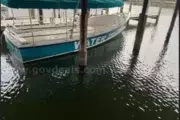This article was republished with permission from WTOP’s news partners at Maryland Matters. Sign up for Maryland Matters’ free email subscription today.
This content was republished with permission from WTOP’s news partners at Maryland Matters. Sign up for Maryland Matters’ free email subscription today.
The Hogan administration is pausing the state’s participation in a multi-state alliance that requires new vehicles sold in Maryland to meet the same emissions standards as those sold in California, a state official said Monday.
The administration’s decision was revealed Monday morning at a meeting of the Air Quality Control Advisory Council, which advises the Maryland Department of the Environment on proposed air quality rules and regulations and evaluates legislation proposed by the General Assembly and state agencies.
Although the emissions standards weren’t on the agenda, an environmentalist asked an official of MDE during the online meeting whether the Hogan administration planned to follow California’s newly-adopted, more stringent emissions standards. The official, Chris Hoagland, director of Air and Radiation at MDE, said Gov. Larry Hogan (R) did not plan to sign an order adopting the so-called Advanced Clean Cars II regulation.
Lindsey Mendelson, the transportation policy specialist at the Maryland chapter of the Sierra Club who raised the question at the air quality council meeting, said she was “very disappointed” by the administration’s decision.
“It’s low-hanging fruit,” she said. “There’s absolutely no reason that the governor shouldn’t adopt the law.”
Maryland has followed California’s emissions guidelines for new cars and light trucks since 2007 — an arrangement that began for 2011 model year cars and trucks. In all, 14 states have been using California regulations, rather than weaker federal rules, as a yardstick for vehicle emissions for several years.
But the original agreement is expiring, and states have been weighing whether to re-up for California’s new, tougher standards, which require vehicle manufacturers to sell an increasing percentage of new zero-emission passenger cars and light-duty trucks in model years 2026 through 2035. The current arrangement runs through the model 2025 year.
The regulation — which aligns with legislation passed by the Maryland General Assembly earlier this year — requires states to allow only new zero-emissions vehicles to be sold after 2035.
The Hogan administration had to decide by the end of this year whether to follow California’s new Advanced Clean Cars II regulation, which was adopted by California’s powerful Air Quality Board in August. Delaware, Massachusetts, New York, Oregon, Vermont, and Washington state have already signed on.
With the Hogan administration opting out, Gov.-elect Wes Moore (D) will have to decide next year whether to bring the state back into the consortium. But even if he does, model year 2027 vehicles sold in the state will have weaker emissions standards than those sold in the states that agree to abide by the California model, because auto manufacturers require a two-year notice of a state’s emissions rules. States that follow the California plan will be required to ensure that at least 43% of the new cars and light-duty trucks sold in model year 2027 are zero emissions or plugged-in hybrids.
The Hogan administration offered no public explanation for why the state won’t follow California’s more stringent standards. The decision contradicts a recommendation from the Maryland Climate Change Commission, which Hogan’s Environment secretary, Horacio Tablada, co-chairs.
Earlier this fall, House Environment and Transportation Committee Chair Kumar Barve (D-Montgomery), along with the chair of that panel’s Motor Vehicle and Transportation subcommittee, Del. David Fraser-Hidalgo (D-Montgomery), and Del. Marc Korman (D-Montgomery), chair of the House Appropriations Subcommittee on Transportation and the Environment, wrote to Hogan, calling the adoption of the Advanced Clean Cars II regulation “our best opportunity to date to significantly mitigate the nation’s leading source of dangerous air and climate pollutants and reduce the State’s reliance on costly, volatile fossil fuels.”
“The ACC II rule in Maryland will further incentivize car manufacturers to accelerate production of pollution-free cars and, ultimately, get more of them into frontline communities,” the lawmakers wrote. “This will be an important step in reducing the costly health impacts of noxious emissions.”
Peter Kitzmiller, president of the Maryland Auto Dealers Association, said Monday that auto manufacturers and dealers are already preparing for the transition to zero-emissions vehicles, regardless of the state’s emissions rules for new cars and light trucks. Currently, about 3.5% of the vehicles on the road in Maryland emit zero emissions, he said.
“The manufactures are spending tens of billions of dollars and the dealers are spending millions of dollars in infrastructure to get ready for this,” Kitzmiller said. “This is obviously the way the market is going to go. Are we going to get there as quickly as some of the regulations require us to? I don’t know.”
This summer, when California announced its latest stringent regulations for emissions of new vehicles, several auto manufacturers applauded them, saying they provided certainty and stability for the industry. A Ford Motor Company executive called it “a landmark standard,” and reiterated the company’s commitment to building zero-emissions vehicles.
The Hogan administration’s plan not to adopt the new California regulation is reminiscent of its decision two years ago to decline to formally join the Transportation and Climate Initiative (TCI), a collaborative effort of mid-Atlantic and Northeastern states to set up a carbon “cap-and-invest” model to transportation emissions — even though Maryland officials had been part of the initial planning for the regional alliance.
Moore, who takes office on Jan. 18, has promised a robust climate agenda, but has offered few specifics. His transition team’s climate policy committee is holding a virtual town hall meeting on Tuesday evening. Leaders of the Air Quality Control Advisory Council have promised to put the California emissions regulations on the agenda for its next meeting in March.







